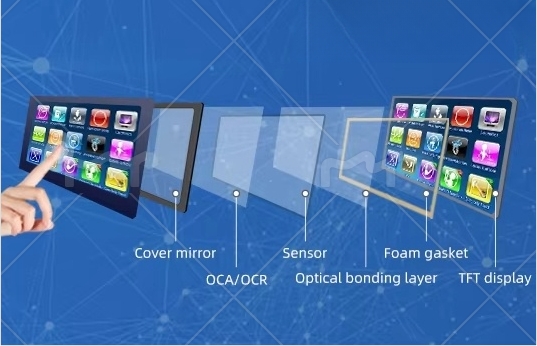Resistive Touch Displays: Features and Benefits
Resistive touch displays are a popular touchscreen technology that relies on pressure-based input. Unlike capacitive touchscreens, which detect changes in an electrostatic field, resistive touchscreens work by physically pressing two conductive layers together. This makes them highly versatile, durable, and cost-effective, particularly in industrial and specialized applications.

Key Features of Resistive Touch Displays
1. Pressure-Based Touch Detection
· Uses two flexible, conductive layers separated by a thin insulating layer.
· When pressure is applied, the layers touch, registering the input.
· Works with fingers, styluses, gloves, or any object.
2. Versatile Input Compatibility
· Unlike capacitive screens, resistive touchscreens can be used with:
Bare fingers
Gloved hands (ideal for medical, industrial, and outdoor use)
Styluses or other objects for precise input
3. Cost-Effective
· More affordable to manufacture compared to capacitive touch technology.
· Ideal for budget-sensitive applications like industrial devices, kiosks, and POS systems.
4. Single-Touch or Limited Multi-Touch Support
· Traditional resistive screens support single-touch input.
· Some advanced versions offer basic dual-touch capabilities, but they do not support multi-touch gestures like pinch-to-zoom.
5. Durability & Ruggedness
· Resistant to scratches and physical impact due to layered construction.
· Works well in harsh environments such as outdoor applications, factories, and medical settings.
· Can be sealed against dust, water, and contaminants, making them suitable for industrial and military use.
6. Works in All Environments
· Operates in extreme temperatures, making them ideal for outdoor and military applications.
· Not affected by water, dust, or moisture, unlike capacitive touchscreens, which may malfunction when wet.
7. Requires Physical Pressure for Activation
· Prevents accidental touches, making it ideal for applications where unintended input must be minimized (e.g., control panels, kiosks).
· Suitable for environments where precision is important, such as medical devices or ATMs.
8. Lower Display Clarity Compared to Capacitive Screens
· The extra touch-sensitive layers can slightly reduce screen brightness and clarity.
· Modern designs have improved light transmission to increase visibility and sharpness.
9. Simple Calibration and Maintenance
· Can be easily calibrated to adjust touch sensitivity.
· Minimal software complexity compared to capacitive touchscreens.
Applications of Resistive Touch Displays

Industrial & Manufacturing
o Used in machine control panels, factory automation systems, and handheld industrial devices.
o Works well in dusty, oily, or wet environments.
Medical & Healthcare
o Found in diagnostic devices, patient monitors, and hospital kiosks.
o Can be used with medical gloves.
Point of Sale (POS) Systems & ATMs
o Reliable for retail checkouts, ticket machines, and vending machines.
o Durable and resistant to heavy usage.
Automotive & Transportation
o Used in car navigation systems, fleet tracking devices, and public transit kiosks.
o Can withstand temperature fluctuations.
Public Kiosks & Vending Machines
o Found in self-service kiosks, public information systems, and touchscreen vending machines.
Outdoor & Military Applications
o Functions in extreme weather conditions and under high-impact usage.
Home Appliances & Consumer Electronics
o Used in microwaves, washing machines, and security systems.
Advantages of Resistive Touch Displays
✔ Lower cost than capacitive displays.
✔ Works with any input device (fingers, stylus, gloves, etc.).
✔ More durable in harsh environments.
✔ Not affected by water or dust.
✔ Reliable for industrial, medical, and public applications.
Conclusion
Resistive touchscreens are an affordable, durable, and versatile choice for many industries. While they lack multi-touch capabilities and high clarity, they excel in rugged environments where precision input and glove compatibility are essential.
Resistive Touch Displays,standard type and customization
